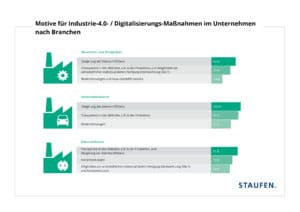
It comes as no surprise that the field of mechanical and plant engineering is leading the way. After all, this sector is traditionally known for its relatively low batch sizes and for adapting its production to meet customer requirements. Industry 4.0 takes this principle to a whole new level. The machine tool manufacturer Trumpf is proof that lot size one is currently a reality as a result of digital transformation: customer configuration starts at the electronic front-end and ends with the distribution of a finished, customized stamping tool. Even other sectors, such as the electronics industry, are clearly following suit. While individual companies might already be successful with lot size one, several manufacturers still have a long way to go. The potential of Industry 4.0 concepts can only be realized once the entire value chain has been integrated. “In mature companies, there are often digital divides, or interfaces, across which machines cannot autonomously communicate. A continuous and homogenous IT infrastructure that includes everything from administration to assembly robots to products is required before profitable customization strategies can be created”, according to Thomas Rohrbach, General Manager of the Staufen subsidiary, Digital Neonex. One spin-off from the digital transformation: High-wage locations might become more attractive again. According to the study participants, in ten years, people will only be 40% involved at the value-added level, which means that the majority of this work will be done by machines. Lower labor costs will result in lower total costs, thereby providing companies with the opportunity to re-explore the possibility of locating production plants in Germany – even when local, agile supply chains are taken into consideration. This view was expressed by 78 percent of the participants surveyed for the German Industry 4.0 Index. “However, we have to make a distinction here. Lot size one might result in reviving Germany as a business location, but we can’t make this assumption. High-value services also have paid accordingly. What this means is that companies have to carefully consider which products and business models are relevant to their customers”, Industry 4.0 expert Rohrbach points out. Despite growing automation and increasingly autonomous machines, the industry would not be able to function without people, even in the future. However, job profiles are evolving. “Even the ‘common laborer’ has to acquire process competency and become a specialist at his/her workstation. At the same time, leadership has to gain digital competency and develop a cooperative leadership style, in order to unleash the innovation potential of employees”, according to Thomas Rohrbach. Download the study “Industry 4.0 Index 2016” Website of Staufen Digital Neonex Press release (.pdf) Press release (.rtf) Download the press graphics (in German)


